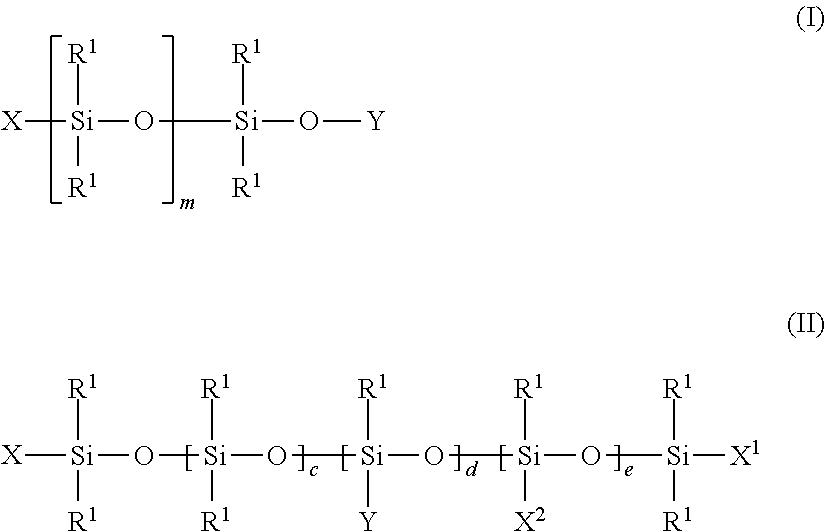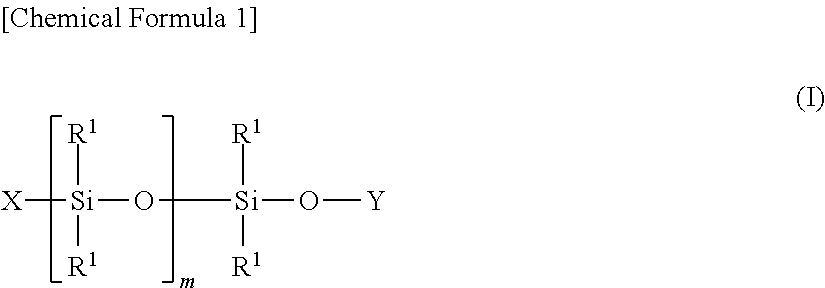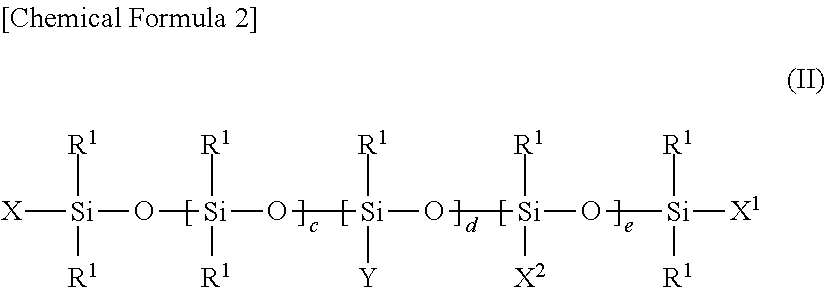Defoamer oil compound, production method therefor, and defoamer composition
a technology of degasification oil and degasification process, which is applied in the field of degasification oil compound, can solve the problems of insufficient initial degasification performance, decreased degasification performance over time, and short degasification performance, and achieves good initial degasification ability, good degasification performance, and good degasification performance. good
- Summary
- Abstract
- Description
- Claims
- Application Information
AI Technical Summary
Benefits of technology
Problems solved by technology
Method used
Image
Examples
example 1
[0134]The following were kneaded for one hour using a planetary mixer: 100 parts by weight of, as an inherently hydrophobic organopolysiloxane, a dimethylpolysiloxane capped at both ends of the molecular chain with trimethylsilyl groups and having a viscosity of 10,000 mm2 / s, 5 parts by weight of AEROSIL 300 (from Nippon Aerosil Co., Ltd.; specific surface area, 300 m2 / g) as a fine silica powder, 0.3 part by weight of a terminal trialkoxy-modified organopolysiloxane (in formula (I), R1 and R2 are CH3, X is Y—O—, Y is —Si(OR2)3, and m is 10) as a silica surface treatment agent, and 0.3 part by weight of water. The temperature was then raised to 150° C. and kneading was continued for 2 hours. The system was cooled to not more than 100° C., following which 2 parts by weight of potassium siliconate containing 3 wt % of potassium hydroxide was added as an alkaline catalyst and the mixture was kneaded for 0.1 hour at not more than 100° C. Next, the kneaded material was raised to a tempera...
example 2
[0136]Emulsion-Type Defoamer Composition (B) was prepared by heating and dissolving a mixture of 20 parts by weight of Silicone Oil Compound (a-1) in Example 1, 4 parts by weight of sorbitan monostearate and 6 parts by weight of polyoxyethylene (55) monostearate, subsequently adding 70 parts by weight of water, and stirring and emulsifying with a homogenizing mixer.
example 3
[0137]The following were kneaded for one hour using a planetary mixer: 100 parts by weight of, as an inherently hydrophobic organopolysiloxane, a dimethylpolysiloxane capped at both ends of the molecular chain with trimethylsilyl groups and having a viscosity of 8,000 mm2 / s, 12 parts by weight of AEROSIL 200 (from Nippon Aerosil Co., Ltd.; specific surface area, 200 m2 / g) as a fine silica powder, and 0.72 part by weight of a terminal trialkoxy-modified organopolysiloxane (in formula (I), R1 and R2 are CH3, X is R1, Y is —Si(OR2)3, and m is 30) as a silica surface treatment agent. The temperature was then raised to 150° C. and kneading was continued for 2 hours. The system was cooled to not more than 100° C., following which 3 parts by weight of potassium siliconate containing 3 wt % of potassium hydroxide was added as an alkaline catalyst and the mixture was kneaded for 0.1 hour at not more than 100° C. The kneaded material was raised to a temperature of 150° C. and kneaded for 2 ho...
PUM
| Property | Measurement | Unit |
|---|---|---|
| specific surface area | aaaaa | aaaaa |
| specific surface area | aaaaa | aaaaa |
| specific surface area | aaaaa | aaaaa |
Abstract
Description
Claims
Application Information
 Login to View More
Login to View More - R&D
- Intellectual Property
- Life Sciences
- Materials
- Tech Scout
- Unparalleled Data Quality
- Higher Quality Content
- 60% Fewer Hallucinations
Browse by: Latest US Patents, China's latest patents, Technical Efficacy Thesaurus, Application Domain, Technology Topic, Popular Technical Reports.
© 2025 PatSnap. All rights reserved.Legal|Privacy policy|Modern Slavery Act Transparency Statement|Sitemap|About US| Contact US: help@patsnap.com



